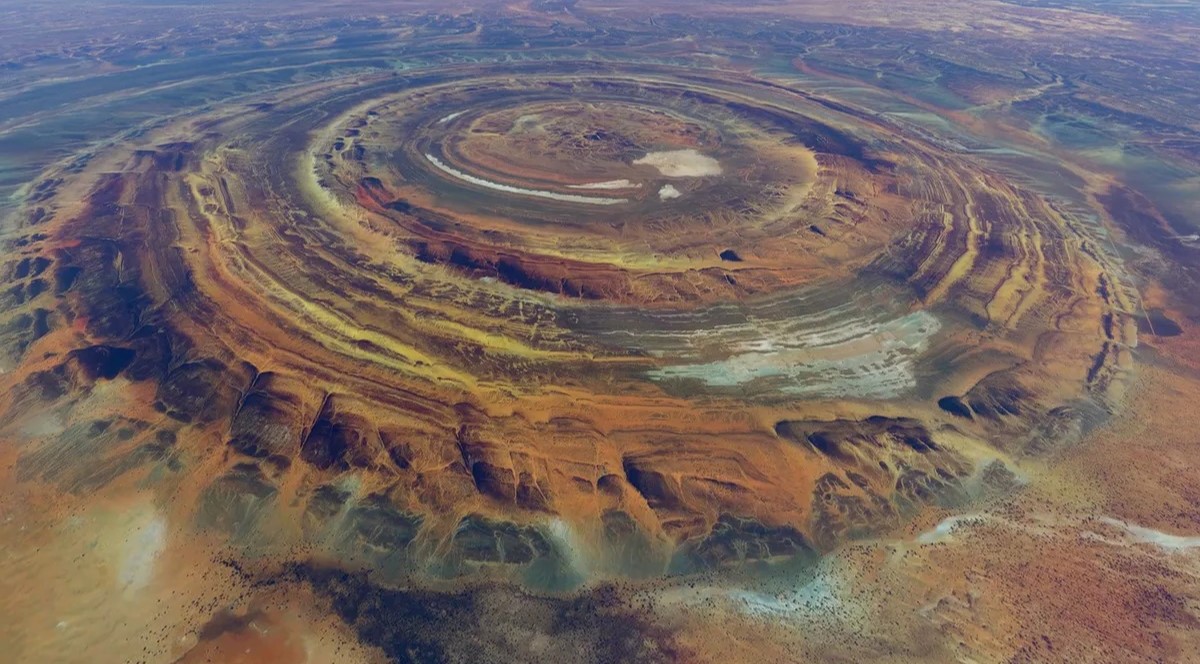Mystery Of The Eye Of Sahara From Above

Have you ever wondered about the Eye of Sahara? This natural wonder, also known as the Richat Structure, looks like a giant bullseye in the middle of the desert. Located in Mauritania, it spans about 25 miles in diameter. From above, it appears as a series of concentric circles, making it a fascinating sight for both scientists and travelers. Some believe it formed from a meteor impact, while others think volcanic activity shaped it. Regardless of its origin, the Eye of Sahara remains one of Earth's most intriguing geological formations. Ready to learn more about this mysterious landmark?
What is the Eye of Sahara?
The Eye of Sahara, also known as the Richat Structure, is a geological wonder located in the Sahara Desert in Mauritania. From above, it looks like a giant bullseye, with concentric circles spanning nearly 50 kilometers in diameter. This natural formation has puzzled scientists and adventurers alike.
How to Get There
Reaching the Eye of Sahara isn't straightforward, but the journey is worth it. Here are some ways to get there:
- Nouakchott: Start your adventure in Mauritania's capital, Nouakchott. From here, you can arrange for a local guide or join a tour group.
- Atar: Fly or drive to Atar, a city closer to the Richat Structure. It's a good base for organizing trips to the Eye.
- 4×4 Vehicles: The Sahara's rugged terrain requires a sturdy vehicle. Rent a 4×4 for the journey from Atar to the Eye.
- Local Guides: Hiring a local guide ensures you won't get lost in the vast desert. They know the best routes and can share fascinating stories about the region.
What to See from Above
Viewing the Eye of Sahara from above offers a unique perspective. Here are some highlights:
- Concentric Circles: The most striking feature is the series of concentric circles. They create a mesmerizing pattern visible from space.
- Geological Layers: Different layers of rock and sediment tell the story of the Earth's history. Each ring represents a different geological period.
- Color Variations: The colors range from deep blues to sandy browns, creating a stunning visual contrast.
- Surrounding Desert: The vast Sahara Desert stretches out in all directions, emphasizing the Eye's isolation and grandeur.
Theories Behind Its Formation
The Eye of Sahara's origin remains a topic of debate. Here are some popular theories:
- Meteor Impact: Some scientists believe a meteor strike created the structure. However, there's no evidence of impact debris.
- Volcanic Activity: Another theory suggests volcanic activity formed the Eye. The lack of volcanic rock challenges this idea.
- Erosion: The most widely accepted theory is erosion. Wind and water gradually wore away the rock, creating the circular pattern.
- Ancient Civilization: Some speculate the Eye was an ancient city or structure. No archaeological evidence supports this theory.
Best Time to Visit
Timing your visit can enhance the experience. Consider these factors:
- Cooler Months: The Sahara can be scorching. Visit between November and February for milder temperatures.
- Clear Skies: Clear skies offer the best views from above. Check weather forecasts before planning your trip.
- Tour Availability: Some tours only operate during peak seasons. Book in advance to secure a spot.
- Local Events: Mauritania hosts cultural events and festivals. Align your visit with these for a richer experience.
Tips for Aerial Photography
Capturing the Eye of Sahara from above requires some preparation. Here are tips for stunning photos:
- Drone Use: Drones offer the best aerial shots. Ensure you have the necessary permits and follow local regulations.
- High-Resolution Camera: Use a camera with high resolution to capture the intricate details of the Eye.
- Golden Hour: Shoot during the golden hour (just after sunrise or before sunset) for the best lighting.
- Wide-Angle Lens: A wide-angle lens captures the full expanse of the Eye and its surroundings.
Nearby Attractions
While in the area, explore other fascinating sites:
- Adrar Plateau: This plateau offers stunning landscapes and ancient rock art.
- Chinguetti: An ancient city with historic libraries and mosques.
- Banc d'Arguin National Park: A UNESCO World Heritage site known for its diverse birdlife.
- Terjit Oasis: A lush oasis with natural springs, perfect for relaxation after your desert adventure.
The Enigma of the Eye of Sahara
The Eye of Sahara, also known as the Richat Structure, remains one of Earth's most intriguing natural formations. From above, its concentric circles look like a giant eye staring back at the sky. This geological wonder has puzzled scientists and adventurers alike, sparking theories ranging from meteor impacts to ancient civilizations. While its true origin is still debated, the Eye of Sahara continues to captivate those who see it. Whether you're a geology enthusiast or just love mysteries, this unique landmark offers a glimpse into the planet's history. Visiting the Eye of Sahara provides not just a visual treat but also a journey into the unknown. So, next time you plan an adventure, consider exploring this enigmatic marvel. It’s a sight you won’t forget.

